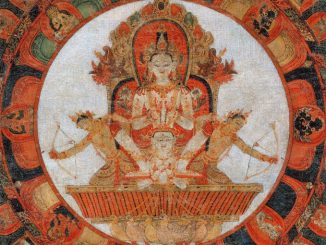
Jae Langton is just like the rest of his family, especially in his love of musicals. The biggest difference is that Jae is South Korean, while everyone else is white. Jae’s parents, Shelley and David, have walked the line for 13 years between celebrating Jae’s Korean culture and letting him know he is just like them.
Jae Langton, like most 13-year-old boys, loves to antagonize his mother. Shelley Langton sighed as her son attempted to tie his socks around his feet and asked, “Can you put them on normal, please?” He put his socks on, rolling his eyes as he did.
Also like most teenage boys, Jae also does not pay much attention to politics. Even though he is Korean, he does not feel like Trump’s policies will hurt him in any way.
“I’m okay during Donald Trump’s presidency because of the fact that I’m from a white family and it doesn’t really affect me that much,” he said.
Jae was adopted from Korea as a baby in 2004 by Shelley and her husband, David, who are both white. They already had a biological daughter, Rachael, who is nine years older than Jae.
“You can see their picture up on the bookcase,” Shelley said, pointing to a large photograph of Rachael, blonde and blue-eyed, holding black-haired Jae.
“That’s the picture from when he came,” Rachael said. “That was in the airport. I was really excited because I wanted to be an older sister really badly, so that was really cool.”
Shelley, Rachael, and Jae sat in the living room together. Rachael and Shelley conversed. Jae played with his phone since his socks were no longer an option.
“I have adopted siblings, a sister and brother who are Korean,” said Shelley. “When David and I got married, we talked about if we would ever adopt, and I said if we did choose to adopt, I would definitely want to adopt from Korea because I have Korean people in my family. So it was very specific.”
Shelley grew up in Minnesota, where there is a large percentage of Korean adoptees in the United States. According to Eleana Kim’s 2011 book Adopted Territory: Transnational Korean Adoptees and the Politics of Belonging from the Duke University Press, other states with larger populations of Korean adoptees include Idaho, Massachusetts, Montana, New York, Oregon, and Vermont.
“I actually asked if we could adopt through the same agency in Minnesota where my parents adopted from because they offer this amazing support service, but they didn’t support homes in New York,” said Shelley. “So they recommended the place where we did end up adopting Jae through, so I said, well, one of the things I was really concerned about and wanted to make sure we had access to was post-adoption supports, not just the getting ready.”
The Langtons live in Ardsley, New York. Jae just graduated from Ardsley Middle School and will attend Ardsley High School in the fall, where Rachael graduated from in 2013.
“Do you have any other friends that are Korean?” Shelley asked Jae.
Jae shook his head. “No.”
“Is there anyone else in your grade who’s Korean?”
“Oh, yes,” he said. He mentioned one other student, a boy in his school named Will.
“Most of your friends are white, though,” said Shelley.
Jae nodded. “Yes,” he said.
Jae knows one person of color that he considers to be a friend, a boy named Aaron who is Turkish, and Shelley said there are several families on their block that are Chinese or Indian. Other than that, Jae said that most of his friends at school are white.
“But you don’t think about it that way, that they’re white and you’re Asian,” said Shelley.
“No,” said Jae.
In addition to the lack of diversity in the schools, Shelley said that the few Korean people from Ardsley she did know were very interested when she told them she was about to adopt Jae. When she told the Korean women working at the local nail salon she was going to adopt from Korea, Shelley said they had a lot of advice.
“They had very mixed feelings in the beginning,” she said.
Rachael nodded. “They want to make sure that you’re raising him right,” she said.
“I mean, it must be strange to be from a culture and seeing a white family raising a kid from that culture,” said Shelley. “We used to have a neighbor across the street who was Korean, and they would invite Jae to come over and play. I think there was a little bit of a sense of ‘He needs to know what his heritage is.’” Often, Shelley said, Jae would come home talking about how he didn’t like the Korean food his friend’s family served.
Today, the rules about adopting from South Korea are even stricter than when Shelley and David adopted Jae. Only couples are allowed to adopt and they have to have been married for at least three years. Couples must be between 25 and 44 years old according to Spence-Chapin, an adoption organization.
At home, even though Shelley and David think it is very important for Jae to know where he came from, they don’t think of him as adopted or Asian.
“I think of him as my son,” said Shelley. “And I guess I think of him as like me. When Trump became president, I think the focus in our family has been more about women and how he treats women. There definitely was a thought about, ‘How is this going to affect people of color?’ and ‘Is this going to affect Jae? Is he going to be targeted in any way?’ But I think a lot of it is the community that we live in. It’s very progressive, very tolerant.”
Shelley and David wanted Jae to have a connection with his Korean culture, even in America. Every year since he was five, Jae participated in Camp Friendship, an organization with a week-long program for Korean children. In the summer of 2018, Jae went back as a counselor.
“His first birthday, we did a whole Korean-themed birthday,” Rachael added. “We had some Korean tradition where the baby has ten items in front of him and the first one he chooses shows something about his future. He chose jujubes.”
“What do jujubes represent?” Shelley asked. “Sweetness?”
“I don’t remember.”
“Hell if I know,” said Jae.
Rachael smiled and said, “He chose them because sugar.”
***
By the time David came home from church, Jae had already gone upstairs to enjoy his Sunday in peace. David joined Shelley and Rachael in the living room, where they discussed Jae’s biological parents.
“We know they were tall,” Rachael said.
“Yeah, we have their education, their heights,” said Shelley. After Jae grew several inches this year, Shelley and David checked the records, wondering about his biological parents. “His biological father is five foot ten,” Shelley added. “It was very tall for a Korean.”
According to Rachael, Jae says he would never want to meet his biological parents. One study on adolescent American adoptees by the American Adoption Congress found that Jae is in the minority: 65 percent of subjects wanted to meet their birth parents.
“At one point, he said he never wanted to meet his biological father,” said Shelley. “He’s very angry. I don’t know why. We never talk about it, except the basics of why a family would give a child up for adoption. We never talked about anything about what might have happened with his biological family. We do know that the mother was college educated and the father was not, so maybe it was something about that, that the parents said, ‘You can’t marry someone who isn’t college educated.’ But there was a while where he was really angry.”
“When he was three, when he got mad at my mom, he would say that she was his third favorite mom,” Rachael said.
“Yeah, well he would say, ‘I wish I hadn’t come here.’”
Rachael laughed. “No, no, he would say, ‘You’re my third favorite mom.’”
“Well, one time, he said, ‘Well, why did I have to come here. I had two other moms,’” said Shelley. “So, one time later, he said, ‘Mom, I love you.’ And I said, ‘Thank you, that’s such a compliment because I know you have two other moms,’ just to tease him a little bit.” Everyone laughed at that.
In addition to Shelley’s brother and sister, David also has cousins who are adopted, though they are white.
“My mom’s only got one brother, and he has a biological son and two adopted daughters,” he said.
“That’s interesting because my friends are always so fascinated by the fact that we’re one biological, one adopted, and I never thought of that as being a weird thing before,” said Rachael. “But my friend does that all the time, where she says, ‘I don’t know how that dynamic would work.’”
Although there are no statistics available, several websites claim that many families have both biological and adopted children, including America’s Adoption Agency.
“Well, I think the age gap is bigger than the difference of adopted versus not adopted,” said David.
“And when we talk to the kids, you know, kids are different,” said Shelley. “Rachael and Jae are different. There’s similarities and there’s differences. And sometimes, when I’m frustrated by the differences, and I talk to families that have all biological kids, they say, ‘Listen, you can have two biological kids who are very different from each other. It’s not just because one’s adopted and one’s biological.’”
“I used to think all these things Rachael did were biological because, well, you know, it’s in the genes,” David said. “She has to love musicals and she has to do stuff that’s just part of being in this family because it’s in the genes. And then I see Jae do them. And I’m like, uh-oh, this is a learned thing.”
“Jujubes Represent Sugar” is an excerpt from Nicole Zelniker’s book Mixed, published by The Nasiona. Of the book, Zelniker writes,
“The definition of families is widening—whether it’s because of mixed-race relationships, interracial adoption, or a number of other factors. Today, it is important to hear from a growing population about race, their shifting identities, and what family means to them.”
Check out her other chapter, “I Guess I’m More Japanese Than You,” in The Nasiona here.
 NICOLE ZELNIKER is a graduate of the Columbia Journalism School and an editorial researcher with The Conversation US. Her work has appeared on The Pulitzer Prizes website and in USAToday and Yes! Weekly, among other places. A creative writer as well as a journalist, Nicole has had several pieces of poetry published including “Cracks in the Sidewalk” (Quail Bell Magazine) and “Surge” (The Greenleaf Review), as well as three short stories, “Last Dance” (The Hungry Chimera), “Dress Rehearsal” (littledeathlit), and “Lucky” (Fixional). Mixed is Zelniker’s first book.
NICOLE ZELNIKER is a graduate of the Columbia Journalism School and an editorial researcher with The Conversation US. Her work has appeared on The Pulitzer Prizes website and in USAToday and Yes! Weekly, among other places. A creative writer as well as a journalist, Nicole has had several pieces of poetry published including “Cracks in the Sidewalk” (Quail Bell Magazine) and “Surge” (The Greenleaf Review), as well as three short stories, “Last Dance” (The Hungry Chimera), “Dress Rehearsal” (littledeathlit), and “Lucky” (Fixional). Mixed is Zelniker’s first book.
Follower her on Twitter and Instagram.
Featured image: Paul Klee, “Baum und Architektur—Rhythmen (Tree and Architecture—Rhythms),” oil on paper, 1920, Gift of Benjamin and Lillian Hertzberg, National Gallery of Art.


